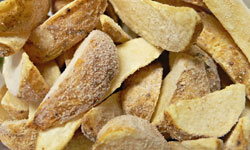Computing optimal food freezing and thawing conditions
Risk assessments for food safety are vital and necessary for asserting food quality and therefore consumer acceptance. Several of these safety and quality aspects arise when food is processed at low temperatures. Optimum freezing and thawing of foods like pork, salmon or potato presupposes accurate knowledge of the thermo-physical properties of water. The SAFE ICE project has accumulated systematic data regarding these properties and, with the aid of elaborate software tools, the optimal food freezing and thawing conditions can be determined. Pressure and temperature are the two critical parameters that control the phase change of any liquid into a solid or vice versa. Water turns into ice at 0°C only when the pressure is 1 Atmosphere, that is, at the usual atmospheric pressure. During this phase change a number of physical parameters are important for food processing. Specific volume, specific heat capacity, thermal expansion coefficient and adiabatic compressibility coefficient for both water and ice must be known at any temperature and pressure combination. The SAFE ICE project has evaluated these parameters and subsequently developed a user-friendly software algorithm that permits calculation of the above parameters for any given values of pressure and temperature. Moreover, with the aid of simple analytical models, an estimation of these thermo-physical parameters has been performed for a number of model gels. Specifically enthalpy, apparent specific heat and thermal conductivity of tylose, a water-soluble, non-ionic cellulose ether, have been evaluated. Data produced from the developed software combined with data obtained from calorimetry studies have been compiled in a CD-ROM. Any thermo-physical property for any food material can now be calculated on the basis of temperature and pressure alone.



